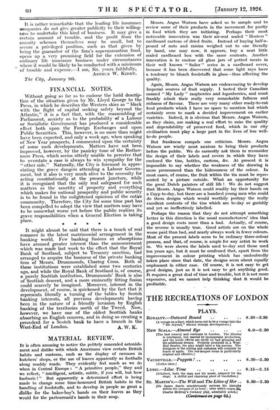MATERIAL REVIEW.
IT is often amusing to notice the politely concealed astonish- ment and dislike with which Americans view certain British habits and customs, such as the display of carcases in butchers' shops, or the use of loaves apparently as footballs along muddy roads. They evidently feel much as we do when in Central Europe : "A primitive people," they and we reflect, "intelligent, artistic, subtle, if you will, but how barbaric I " But apparently a determined effort is being Made to change some time-honoured British habits in the handling of foodstuffs, and to develop in people as great a dislike for the baker-boy's hands on their loaves as they would for the parlourmaid's hands in their soup. Messrs. Angus Watson have asked us to sample and to review some of their products in the movement for purity in food which they are initiating. Perhaps their most noticeable innovation was their air-seal sealed " Hostess " cardboard cartons of dried fruits. Instead of buying half-a- pound of nuts and raisins weighed out to one literally by hand, one may now, it appears, buy a neat little sealed cardboard box with the same contents. Another innovation is to enclose all glass jars of potted meats in their well known " Sailor " series in a cardboard cover, because it has been discovered that some light rays have a tendency to bleach foodstuffs in glass—thus affecting the quality.
Again, Messrs. Angus Watson are endeavouring to develop Imperial sources of fruit supply. I tasted their Canadian canned "My Lady" raspberries and loganberries, and must frankly admit their really very remarkable fullness and richness of flavour. There are very many other ready-to-eat food products which I have no space to mention but which certainly seem to mark a decided improvement on earlier varieties. Indeed, it is obvious that Messrs. Angus Watson, as they claim, are making a real effort to raise the quality and dependability of preserved food, which in our city civilization must play a large part in the lives of less well- to-do people.
But frankness compels one criticism. Messrs. Angus Watson are wisely most anxious to bring their products before the public. We do earnestly ask them to reconsider the design of their labels and covers in which they have enclosed the tins, bottles, cartons, &c. At present it is impossible to say whether the weakness of the drawing is more pronounced than the hideousness of the colour. In most cases, of course, the fruit within the tin must be repre- sented by a picture outside. What an opportunity for the great Dutch painters of still life We do not suggest that Messrs. Angus Watson could readily lay their hands on a Cuyp to-day, but there are a hundred young men who could do them designs which would worthily portray the really excellent contents of the tins which are to-day so garishly and yet so ineffectively labelled.
Perhaps the reason that they do not attempt something better in this direction is the usual manufacturers' idea that a good design costs more than a bad. Actually, of course, the reverse is usually true. Good artists are on the whole worse paid than bad, and nearly always work in fewer colours. Most of the present labels seem to be ordinary three-colour process, and that, of course, is ample for any artist to work in. We were shown the labels used to-day and those used ten years ago, but it must be confessed that, apart from the improvement in colour printing which has undoubtedly taken place since that date, the designs seem about equally unpleasant in either case. Of course, it is not easy to get good designs, just as it is not easy to get anything good. It requires a great deal of time and trouble, but it is not more expensive, and we cannot help thinking that it would be profitable.






































 Previous page
Previous page